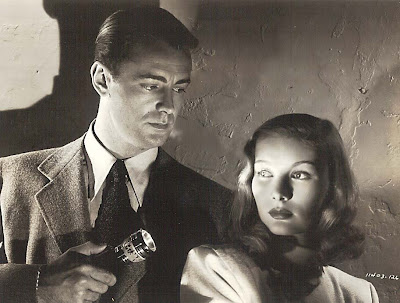
A good film is always a joy to watch. Sometimes a bad film can be a joy just because it's fun to mock it or to laugh at the unintentional humor. But I want to talk about something that is rarely loved--the mediocre film. The main joy that I get from mediocre films is re-writing them in my head. Often these movies have a great deal of potential and you can see where the writers went wrong. The Norma Shearer/Herbert Marshall melodrama,
Riptide, for example was just begging to be produced as a comedy. I spent more time imagining the scenes re-written as farce than I did watching the movie. Any movie is worthwhile that lingers in your mind for more than the run-time of the film. This probably accounts for why I give so few negative reviews to films on my blog.
Girl's Dormitory (1936) had every promise of being a bad film: a somewhat lurid title, the whiff of scandal, and an unseemly love triangle between two teachers and a pupil at a vaguely European boarding school. Perhaps if this film had been made a few years earlier it could have really sunk deep in the swamp of these tantalizingly tawdry motifs. It might have even elevated itself to the status of legendary camp or better yet, it could have miraculously become a good film. It might have actually made an honest exploration of the various power imbalances inherent in May-September romances. It could have been "Lolita" ahead of its time. Simone Simon would have made an astoundingly effective Lo. Though she was 26 in 1936, she came off as younger even than the 19 years she is supposed to be in the film. She also has a worldliness about her that it is probably simplistic to describe as merely "French," an epithet hurled at her in one scene. She instinctively knows that her older, stodgy, quarry is going to need more prodding than usual. It's too bad for the film that her rival doesn't have those same Gaelic instincts. Speaking of Lolita, there is even a creepy scene in the movie where Herr Director Stephen Dominik (Herbert Marshall) talks with nostalgia about what Marie (Simon) was like when she came to the school at age 15. Another scene, in which Marie unceremoniously dumps Dominik, shows me that the filmmakers understood some of these imbalances but weren't brave enough to spell them out. Marshall creates Humbert Humbert twenty years before Nobokov even dreamed of him, briefly, in that scene as a mixture of heartbreak, humiliation and utter desperation plays across his face.
What we are left is a post-code romance that is set-up to be fairly formulaic and even there it could have turned out to be a better movie than it did. Everything in the movie is crying out for Dominik to realize his mistake and admit that he's in love with fellow teacher, Anna, ably played by Ruth Chatterton. With more loose ends than an old tapestry, a very short run-time at under 80 minutes, it seems like the filmmakers just panicked and left the audience with an unsettling, contrived "happy" ending between Dominik and Marie. This is further confused by the presence of a very young Tyrone Power whom I was completely convinced was brought on board in the final reel to remove the young girl from the neck of our very middle-aged hero. (Marshall was actually 46 when he made this movie, though he makes a fairly convincing 37. He did have a baby face. ) I guess I wanted
The Bachelor and the Bobbysoxer: the uncomfortable older man played for laughs juxtaposed with a comically serious young heroine. I would have even been happy with the story left as melodrama, as long as it had a different ending, not so favor of youth and beauty.
One of the more glaring unresolved plot dilemmas is the investigation into Marie's supposed affair which is sparked by a pretend love letter she writes to Dominik. After a group of hard-nosed faculty threaten to call the girl's invalid mother into the school, she runs away in a rainstorm, Bronte style, nearly jumps off a cliff and spends enough of the night unchaperoned in a cabin with the good Herr Director to cause suspicion. Instead of seeing this as an admission of guilt or evidence of a deeper conspiracy, these teachers, whose actions were unbelievably prosecutorial to begin with, suddenly have a change of heart and see her disappearance as proof that she wasn't guilty. It gets worse. Dominik is made aware that Anna is in love with him, but this revelation has no effect on him, despite the three or four scenes to the contrary earlier in the film. I can see problems for his character either way he chooses to go. Sting didn't write "Don't Stand So Close to Me" in a vacuum. This situation could pretty much wreck his career no matter what. There is a narrow ledge that comedy walks to rid itself of the taint of unfair scandal, and it usually involves a public trial in which the true feelings of all the characters are revealed. Frank Capra knew this which is why he employed the device so often. Though the movie had a golden opportunity for such a set-piece through the investigation, it is never utilized.
The few people whom I've seen comment on this film have felt that it simply puts forth outdated mores. When one of the teachers says "After all, she is 19. My mother had two children by the time she was that age," it caused me to involuntarily squirm in my seat. Perhaps audiences in 1936 were OK with characters marrying young or more ready to accept the idea of an older man with a much younger woman, but I still think they would find the notion that a middle-aged man would throw over the very attractive and devoted colleague for a girl half his age to be a bit foolish. I can't imagine that audiences would buy the way in which Chatterton gracefully bows out, counseling both of them as her friends as an acceptable fate. It's made worse by the fact that all this is done off-screen and is summed up in an after-the-fact conversation at the end of the film. And what about the disadvantages for Marie? Is she going to wake up some day at 35 and find her self married to an old man? I simply refuse to buy the "outdated" argument. The mores described in this movie are more than just outdated, they are simplistic, wrong-headed and they must have appeared so, even in 1936. Indeed, the contemporaneous
New York Times review says as much, while going on at length about the charms of Si-MOAN Si-MOAN.
 Irving Berlin's overture at the beginning of Top Hat (1935) is a plunging, slightly menacing downward flight of notes punctuated visually with the clack of Gentleman's walking sticks. From this opening the movie creates a wonderful sense of anticipation. The story opens in a London Gentleman's club where a sign tells us that absolute silence is to be observed. As Fred Astaire appears from behind a newspaper and attempts to carry on a conversation through mime with Edward Everett Horton, it seems inevitable that he is going to be violating that sign in some really big way. He does. Just as he's about to exit he lets out a barrage of tap dance that leaves the old boys falling out of their chairs.
Irving Berlin's overture at the beginning of Top Hat (1935) is a plunging, slightly menacing downward flight of notes punctuated visually with the clack of Gentleman's walking sticks. From this opening the movie creates a wonderful sense of anticipation. The story opens in a London Gentleman's club where a sign tells us that absolute silence is to be observed. As Fred Astaire appears from behind a newspaper and attempts to carry on a conversation through mime with Edward Everett Horton, it seems inevitable that he is going to be violating that sign in some really big way. He does. Just as he's about to exit he lets out a barrage of tap dance that leaves the old boys falling out of their chairs.












